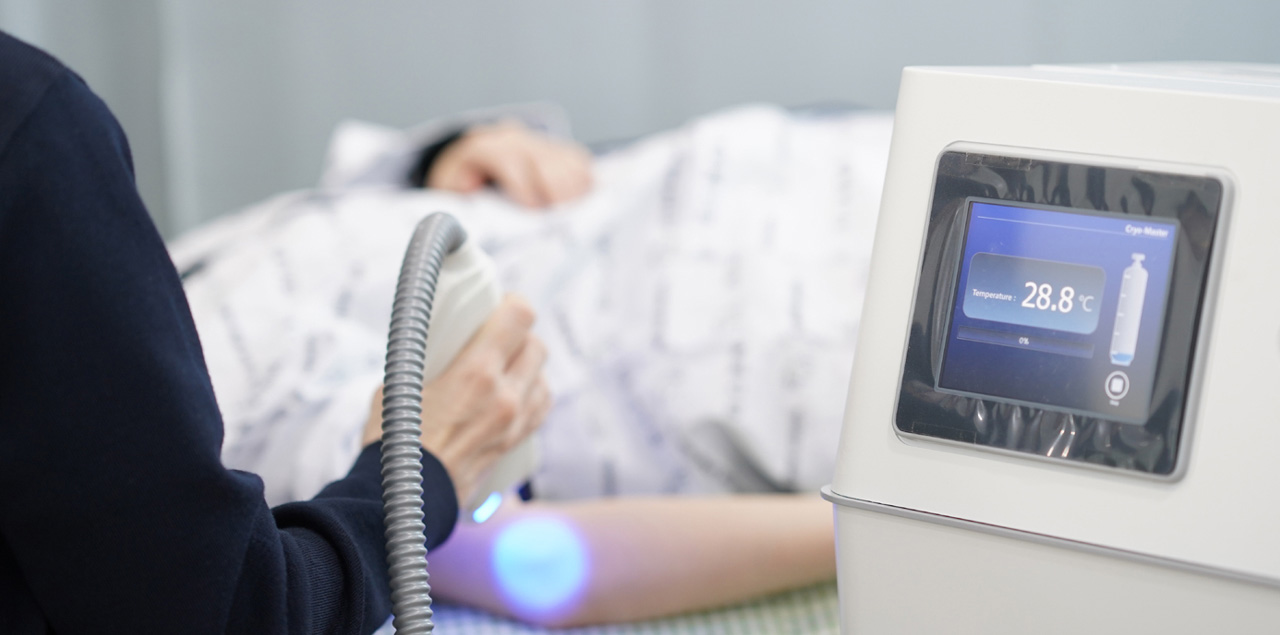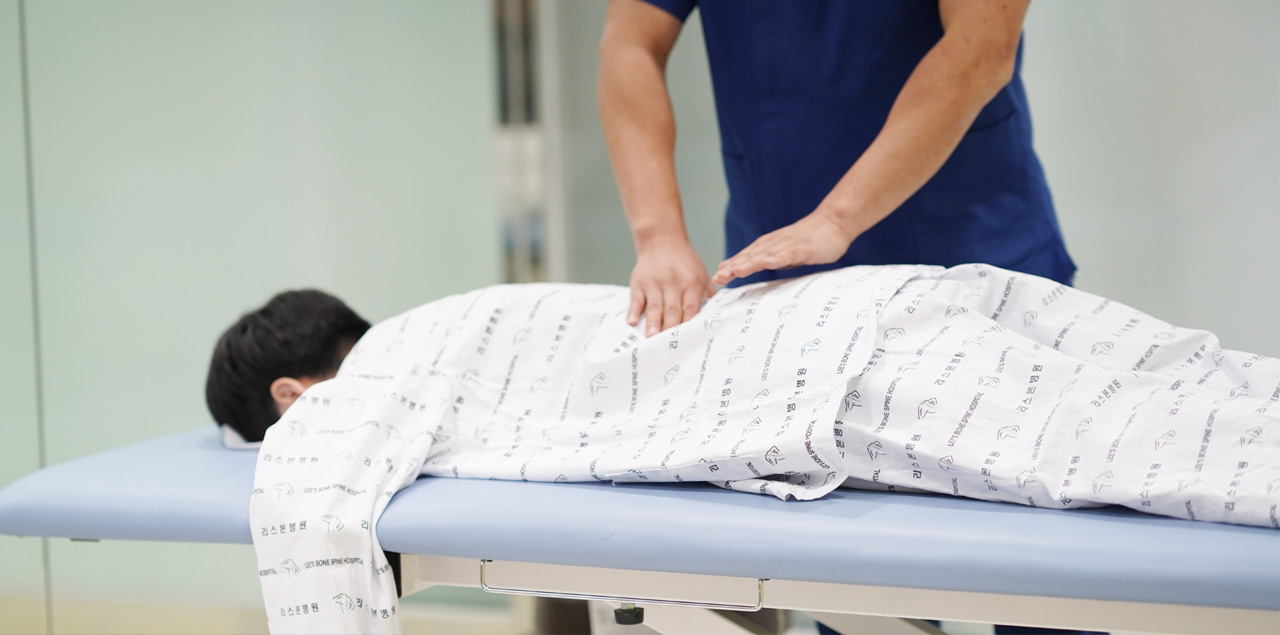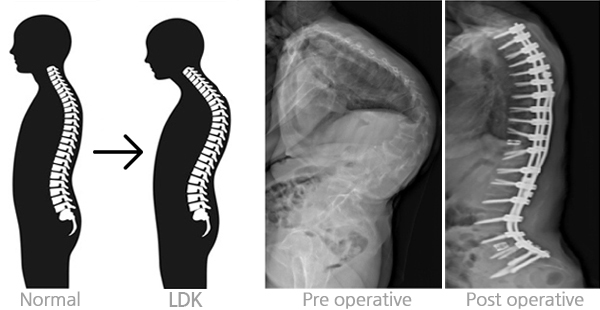Spine
Lumbar disc

Spinal stenosis

Degenerative Disc Disease

Spondylolisthesis

Spondylolysis

Compression fracture

Scoliosis

Lumbar Degenerative Kyphosis

Cervical herniated nucleus

Ossification of posterior longitudinal ligament

CTurtle neck syndrome

Nerve Block
Nerve Block
Nerve Block is a treatment method that involves injection of a medication around the nerve branches escaped from the spinal cord, causing low back pain.
As for low back pain caused by pinched nerves, this Nerve Block involves direct injection of a medication to the part where patients experience pain to reduce inflammation and swelling and to stabilize overactive nerves for improving the symptoms.

-
Characteristics of the Procedure
- The procedure is completed within a relatively short period of time, about 20 to 30 minutes.
- Patients are not required to be hospitalized and allowed to return home and to their normal life within one to two hours.
- The procedure is done without an incision and pains are recovered quickly.
- Even elderly patients and patients with chronic diseases such as hypertension, heart disease and diabetes mellitus can receive the procedure safely.
-
Who We Treat
- Patients with chronic disc
- People with arm, leg, and neck pain due to pinched nerves
- People with pain after spine surgery or whose pain got worse
- Patients with degenerative spinal disease
- Patients who cannot receive surgery due to their old age
- Patients who cannot receive surgery due to medical complications
-
Diseases We Treat
- Neck Disease: cervical herniated nucleus, straight neck, myofascial pain syndrome
- Shoulder Disease: adhesive capsulitis, rotator cuff tear
- Spinal Disease: lumbar disc, scoliosis, spinal stenosis
Percutaneous Epidural Neuroplasty(PEN)
Percutaneous Epidural Neuroplasty(PEN)
Percutaneous Epidural Neuroplasty(PEN) is a procedure developed by Dr. Racz, a famous physician for pain management medicine in the U.S.
This procedure is done by inserting a special catheter (with a diameter of 1mm and a length of 40-50cm) with needle into the area of pain directly through the tailbone to loosen/release adhesions and administering anti-inflammatory drugs to treat the inflammation causing pain and swelling and the adhesion around nerves.

-
Characteristics of the Procedure
- The procedure is completed within a relatively short period of time, about 20 to 30 minutes.
- Anyone can receive the procedure regardless of age, the presence of diabetes, or the level of blood pressure.
- The procedure takes place using a real time imaging technique (C-Arm) to precisely detect an adhesion and treat safely.
- Patients do not undergo general anesthesia and the procedure rarely leaves a surgical scar
-
What We Treat
- Cervical Herniated Nucleus, Lumbar Disc, Spinal Stenosis, Tingling in the Hands and/or Feet, Spondylolisthesis, Pain after Spine Surgery, Acute/Chronic Low Back Pain, Neck Pain
-
Do’s and Don’ts After the Procedure
- Patients should lie down straight and get rest for at least an hour after the procedure.
- On the first and second days after the procedure, patients should not do strenuous activities as possible as they can.
- On the second day after the procedure, patients are allowed to take a quick shower and after a week, they are allowed to take a bath.
- After the procedure, patients should receive both the prolotherapy to improve ligaments of the spine and the nutrient injection for pain tolerance in order to boost treatment effects.
- To prevent recurrent spinal disease, patients should receive manual therapy, core exercise to strengthen the deep back muscles.
- Since these should take place when pain is controlled, patients should consult a medical specialist.
- On top of everything else, treatment persistence, regular eating and exercise, good posture, healthy habits, and stress management are more important.
Balloon Expansion Neuroplasty
Balloon Expansion Neuroplasty
This is a non-surgical treatment method using a special catheter involving balloon inflation for patients whose spinal canal becomes narrowed due to spinal stenosis.
Different from PEN that releases adhesion using a tip of catheter and that injects a drug, a surgeon uses a balloon to sufficiently expand the area of stenosis and administers the enzyme that dissolves an adhesion between the area of stenosis and nerve and the anti-inflammatory drug that reduces neuritis causing pain and swelling. So, it is a more effective treatment method.

-
Characteristics of the Procedure
- It takes place using a real time imaging technique (C-Arm) to achieve a higher level of precision and patient safety.
- A special balloon catheter was invented to greatly reduce a nerve damage.
- As patients do not undergo general anesthesia, elderly patients or patients with chronic diseases like diabetes mellitus, hypertension, or osteoporosis can undergo the procedure.
- The procedure is completed in a short period of time, about 20 to 30 minutes and patients can go back to their normal life after getting rest for some time.
-
Who We Treat
- Patients with Spinal Stenosis
- Patients with Spondylolisthesis
- Patients with Acute/Chronic Low Back Pain
- Patients with Tingling in the Feet due to Stenosis
- Patients with Pain after Spine Surgery
-
Do’s and Don’ts After the Procedure
- Patients should lie down straight and get rest for at least an hour after the procedure.
- On the first and second days after the procedure, patients should not do strenuous activities as possible as they can.
- On the second day after the procedure, patients are allowed to take a quick shower and after a week, they are allowed to take a bath.
- Sutures will be removed after three to seven days.
- After the procedure, patients should receive both the prolotherapy to improve ligaments of the spine and the nutrient injection for pain tolerance in order to boost treatment effects.
- To prevent recurrent spinal disease, patients should receive manual therapy, core exercise to strengthen the deep back muscles.
- Since these should take place when pain is controlled, patients should consult a medical specialist.
- On top of everything else, treatment persistence, regular eating and exercise, good posture, healthy habits, and stress management are more important.
Radiofrequency Nucleoplasty
Radiofrequency Nucleoplasty
Radiofrequency Nucleoplasty is a non-surgical treatment method by precisely examining the disc through a real time imaging technique (C-Arm).
After a local anesthesia, a surgeon inserts a special needle into the area of pain in order to allow the disc that was escaped to contract or coagulate using a 40 to 50-degree Celsius of high heat frequency.
The high heat frequency reduces the internal pressure of the disc, strengthens the disc wall, and blocks abnormal nerves around the damaged fibrous ring in order to treat causes of the symptom.

-
What Disease We Treat
- Lumbar Disc, Sciatica, Chronic Low Back Pain, Disc Disease to which physical therapy is not effective, Disc Disease to which drug therapy is not effective, and Disc Disease to which injection is not effective
-
Who We Treat
- Patients with Spinal Disc
- Patients with Cervical Herniated Nucleus
- Patients with Degenerative Disc Disease
- Patients with Low Back Pain and Lower Limb Pain due to Chronic Disc
- Patients with Internal Disc Derangement
-
Do’s and Don’ts After the Procedure
- Patients should not do strenuous activities for some time after the procedure.
- After the procedure, patients should receive both the prolotherapy to improve ligaments of the spine and the nutrient injection for pain tolerance in order to boost treatment effects.
- To prevent recurrent spinal disease, patients should receive manual therapy, core exercise to strengthen the deep back muscles.
- Since these should take place when pain is controlled, patients should consult a medical specialist.
Rehabilitation
Rehabilitation
At Lee’s Bon Spine & Joint Hospital, special physical therapists help to relieve pain after surgery with remedial therapies using different methods such as manual therapy, extracorporeal shock wave therapy, remedial exercise, or posture correction.
It improves treatment effects on spine and joint pain as well as on sports injuries like nerves, muscles and joint diseases.

Manual Therapy

Endoscopic Spine Procedure
Endoscopic Spine Procedure
A surgeon uses an endoscopic tube to insert inside the disc and then, through an endoscope, he/she uses micro-instruments and high frequency instruments to treat the disc diseases.
As the procedure requires only a local anesthesia, it leaves almost no surgical scar and as it has a short recovery time, patients are discharged within 1 to 2 days.

-
Characteristics of the Procedure
- As the procedure requires only a local anesthesia, weak elderly patients or patients with diabetes mellitus can also undergo the procedure.
- The procedure is done with less than a 1-cm skin incision that rarely leaves a surgical wound or scar.
- Patients will feel almost no pain after the procedure and can recover quickly.
- As bleeding rarely occurs, a blood transfusion is not needed that prevents complications in blood transfusion such as HIV or Hepatitis.
- Incidence of nerve damage or nerve adhesion, the most dangerous complications after the procedure involving incision, is extremely rare.
-
Who We Treat
- Patients with Discogenic Low Back Pain
- Patients with Degenerative Disc Disease
- Patients with Internal Disc Derangement
- Patients with Soft Disc in the Neck or Low Back
Minimally Invasive Spine Surgery
Minimally Invasive Spine Surgery
Minimally Invasive Spine Surgery requires small incisions, and using a surgical microscope, a surgeon removes herniated disc and performs spinal fusion surgery and pedicle screw fixation.
As it leaves minimal pain after surgery, reduces complications in blood transfusion and gives faster recovery, the surgery requires short hospitalization, so patients can go back to their normal life quickly.

-
What Disease We Treat
- As the case may require, the surgery will take place under spinal anesthesia in elderly patients or high-risk patients.
- As a minimal-incision surgery, it takes shorter time to perform and minimizes surgical scar and blood transfusion. So, patients will have a shorter recovery time.
Surgeries with High Degree of Difficulty
Surgeries with High Degree of Difficulty
Cervical Spine Surgery is a spine articulation which generally requires a high-level technique
As for upper cervical injuries or diseases, it is very difficult to perform, requiring extreme concentration, since spinal nerves are passing and main blood vessels are distributed. So, these surgeries require highly skilled and experienced surgeons.

Spinal Deformity (Scoliosis / Lumbar Degenerative Kyphosis)
-
Scoliosis
- It is a condition in which spine has an abnormal sideways curve when spine arrangement is viewed from the front or the side.
- In a normal spine, the curve Is ‘S-shaped’ when viewed from the front or the side. But, when this curve is deformed, it leads to the pressure on a particular area of the spine and causes pain.
- It occurs mostly in adolescents and if spinal deformity is severe, having an angle of 40 to 50 degrees or more, surgery is required to correct the curve.
-
-
Lumbar Degenerative Kyphosis
- It is a disorder in which a forward rounding of the back resulting in a curvature of the spine. Surgery is required if it is accompanied by normal activity or walking difficulties.
- This is one of the difficult surgeries that requires synostosis and posterior pedicle screw fixation.
-

